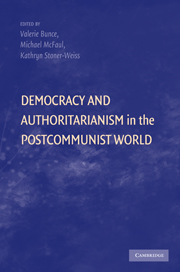Book contents
- Frontmatter
- Contents
- Prologue
- PART I WAVES OF REGIME CHANGE: FROM DICTATORSHIP TO DEMOCRACY…AND BACK?
- PART II ENCOURAGING DEMOCRACY: THE ROLE OF THE EUROPEAN UNION
- PART III CHOOSING REGIME CHANGE: DEMOCRATIZING ELECTIONS
- PART IV RESISTING REFORM: BACKSLIDING DEMOCRACIES AND ENDURING AUTOCRACIES
- 9 Resistance to Contagion
- 10 Comparing Oranges and Apples
- 11 Contagion Deterred
- 12 A Horse of a Different Color
- Epilogue
- Index
- References
12 - A Horse of a Different Color
Revolution and Regression in Kyrgyzstan
Published online by Cambridge University Press: 05 June 2012
- Frontmatter
- Contents
- Prologue
- PART I WAVES OF REGIME CHANGE: FROM DICTATORSHIP TO DEMOCRACY…AND BACK?
- PART II ENCOURAGING DEMOCRACY: THE ROLE OF THE EUROPEAN UNION
- PART III CHOOSING REGIME CHANGE: DEMOCRATIZING ELECTIONS
- PART IV RESISTING REFORM: BACKSLIDING DEMOCRACIES AND ENDURING AUTOCRACIES
- 9 Resistance to Contagion
- 10 Comparing Oranges and Apples
- 11 Contagion Deterred
- 12 A Horse of a Different Color
- Epilogue
- Index
- References
Summary
If Ukraine was destined to have a democratic breakthrough because of the dream of a “return to Europe,” and Georgia, a Christian, historically Russophobe country, maintained the possibility of joining NATO and perhaps one day the European Union, then Kyrgyzstan, a small, mostly Muslim country in Central Asia surrounded by repressive authoritarian countries, had few external incentives for a democratic revolution. Neither were the internal conditions especially propitious: Kyrgyzstan is a poor country with a weak civil society that, prior to 1991, had no history as an independent state. President Askar Akaev, once known as a liberalizer, in later years backtracked on his early reforms and pushed Kyrgyzstan in a more autocratic direction. Nevertheless, to the surprise of many, Akaev was overthrown in 2005 following fraudulent parliamentary elections, leading to only the second transfer of power in Central Asia since independence. Kyrgyzstan thus appeared to join the wave of popular uprisings that began in Eastern Europe, traveled east through former Soviet, but still ostensibly European, nations, and finally ended up in the heart of Asia.
How are we to make sense of this case, which, on one hand, lacked most of the structural prerequisites for democracy – a middle class, a high level of development, a tradition of nationalism, and some prior experience with democracy or independent statehood – but on the other hand showed some promising signs of pluralism?
- Type
- Chapter
- Information
- Democracy and Authoritarianism in the Postcommunist World , pp. 300 - 324Publisher: Cambridge University PressPrint publication year: 2009
References
- 1
- Cited by



